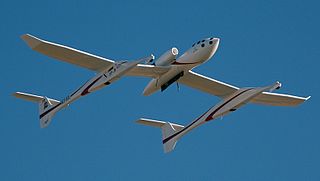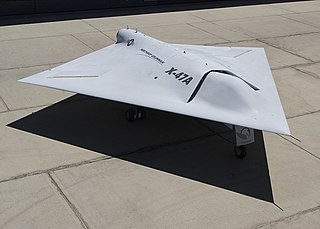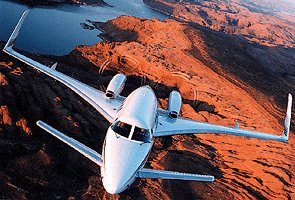Related Research Articles

Elbert Leander "Burt" Rutan is a retired American aerospace engineer and entrepreneur noted for his originality in designing light, strong, unusual-looking, and energy-efficient air and space craft. He designed the record-breaking Voyager, which in 1986 was the first plane to fly around the world without stopping or refueling. He also designed the Virgin Atlantic GlobalFlyer, which in 2006 set the world record for the fastest and longest nonstop non-refueled circumnavigation flight in history. In 2004, Rutan's sub-orbital spaceplane design SpaceShipOne became the first privately funded spacecraft to enter the realm of space, winning the Ansari X-Prize that year for achieving the feat twice within a two-week period.

A propfan, also called an open rotor engine, open fan engine or unducted fan, is a type of aircraft engine related in concept to both the turboprop and turbofan, but distinct from both. The design is intended to offer the speed and performance of a turbofan, with the fuel economy of a turboprop. A propfan is typically designed with a large number of short, highly twisted blades, similar to the (ducted) fan in a turbofan engine. For this reason, the propfan has been variously described as an "unducted fan" (UDF) or an "ultra-high-bypass (UHB) turbofan".

The Pratt & Whitney Canada PT6 is a turboprop aircraft engine produced by Pratt & Whitney Canada. Its design was started in 1958, it first ran in February 1960, first flew on 30 May 1961, entered service in 1964, and has been continuously updated since. The PT6 consists of two basic sections: a gas generator with accessory gearbox, and a free-power turbine with reduction gearbox. In aircraft, the engine is often mounted "backwards," with the intake at the rear and the exhaust at the front, so that the turbine is directly connected to the propeller. Many variants of the PT6 have been produced, not only as turboprops but also as turboshaft engines for helicopters, land vehicles, hovercraft, and boats; as auxiliary power units; and for industrial uses. By November 2015, 51,000 had been produced, which had logged 400 million flight hours from 1963 to 2016. It is known for its reliability, with an in-flight shutdown rate of 1 per 651,126 hours in 2016. The PT6A turboprop engine covers the power range between 580 and 1,940 shp, while the PT6B/C are turboshaft variants for helicopters.

The Scaled Composites Model 318 White Knight is a jet-powered carrier aircraft that was used to launch its companion SpaceShipOne, an experimental spaceplane. The White Knight and SpaceShipOne were designed by Burt Rutan and manufactured by Scaled Composites, a private company founded by Rutan in 1982. On three separate flights in 2004, White Knight conducted SpaceShipOne into flight, and SpaceShipOne then performed a sub-orbital spaceflight, becoming the first private craft to reach space.

The Northrop Grumman X-47 is a demonstration unmanned combat aerial vehicle. The X-47 began as part of DARPA's J-UCAS program, and is now part of the United States Navy's UCAS-D program to create a carrier-based unmanned aircraft. Unlike the Boeing X-45, initial Pegasus development was company-funded. The original vehicle carries the designation X-47A Pegasus, while the follow-on naval version is designated X-47B.

The Beechcraft Starship is a twin-turboprop six- to eight-passenger pressurized business aircraft produced by Beech Aircraft Corporation. Notable for its unusual canard design and extensive use of carbon fiber composite, it did not sell many units and production ceased in 1995, only six years after the Starship's first flight.

The Short 330 is a small turboprop transport aircraft produced by Short Brothers. It seats up to 30 people and was relatively inexpensive and had low maintenance costs at the time of its introduction in 1976. The 330 was based on the SC.7 Skyvan. The C-23 Sherpa was a military version of the 330. Production of the aircraft ended in 1992, after 141 were produced. The Short 360 was a development of the Short 330.

The General Electric GE36 was an experimental aircraft engine, a hybrid between a turbofan and a turboprop, known as an unducted fan (UDF) or propfan. The GE36 was developed by General Electric Aircraft Engines, with its CFM International equal partner Snecma taking a 35 percent share of development. Development was cancelled in 1989.

The Scaled Composites ARES is a demonstrator aircraft built by Scaled Composites. ARES is an acronym for Agile Responsive Effective Support.

The McDonnell Douglas F-15 STOL/MTD is a modified F-15 Eagle. Developed as a technology demonstrator, the F-15 STOL/MTD carried out research for studying the effects of thrust vectoring and enhanced maneuverability. The aircraft used for the project was pre-production TF-15A (F-15B) No. 1, the first two-seat F-15 Eagle built by McDonnell Douglas, the sixth F-15 off the assembly line, and was the oldest F-15 flying up to its retirement. It was also used as the avionics testbed for the F-15E Strike Eagle program. The plane was on loan to NASA from the United States Air Force.

The SOCATA TBM is a family of high-performance single-engine turboprop business and utility light aircraft manufactured by Daher. It was originally collaboratively developed between the American Mooney Airplane Company and French light aircraft manufacturer SOCATA.

The PZL-230 Skorpion (scorpion) was a proposed Polish low-cost attack aircraft. It was being developed by Polish manufacturer PZL Warszawa-Okecie in the late 1980s and early 1990s.

The Williams V-Jet II was designed and built by Burt Rutan's Scaled Composites for Williams International as a test bed and demonstrator aircraft for Williams' new FJX-1 turbofan engine.

The Scaled Composites Triumph is a twin-engine, business jet prototype designed and built by Burt Rutan's Scaled Composites for Beechcraft. It was known officially as the Model 143, and internally at Scaled as the "Tuna". The aircraft is a three lifting surface design, with both a small canard, and a small conventional horizontal stabilizer in a T-tail configuration.

The Avtek 400A was an American prototype turboprop-powered business aircraft developed in the early 1980s. It was of unusual and distinctive configuration: a low-wing monoplane with two pusher engines mounted above the wings, and a large canard mounted atop the forward fuselage. The aircraft's sleek, futuristic design earned it a guest appearance on the Airwolf TV series as the X-400, the plane used by the villain Lou Stappleford in the episode Eagles.

Aurora Flight Sciences (AFS) is an American aviation and aeronautics research subsidiary of Boeing that specializes in special-purpose unmanned aerial vehicles. Aurora's headquarters is at Manassas Regional Airport.
The Scaled Composites Model 367 BiPod is an experimental flying car developed by Scaled Composites. It was the final aircraft designed by Burt Rutan prior to his retirement.

A three-surface aircraft or sometimes three-lifting-surface aircraft has a foreplane, a central wing and a tailplane. The central wing surface always provides lift and is usually the largest, while the functions of the fore and aft planes may vary between types and may include lift, control and/or stability.

The Allison T56 turboprop engine has been developed extensively throughout its production run, the many variants are described by the manufacturer as belonging to four main series groups.
References
- ↑ North Aviation Week & Space Technology October 13, 1986, pp. 28–29.
- ↑ Flight International January 30, 1988, p. 9.
- ↑ Scott Aviation Week & Space Technology January 18, 1988, p. 26.
- ↑ Scott Aviation Week & Space Technology September 4, 1989, p. 38.
- ↑ Aviation Week & Space Technology April 17, 1989, p. 20.
- ↑ Scott Aviation Week & Space Technology September 4, 1989, p. 49.
- ↑ Flight International July 8, 1989, p. 16.
- ↑ Lambert 1990, pp. 495–496.
- "AT3 Testing Ends". Flight International . Vol. 136, no. 4172. July 8, 1989. p. 16. Retrieved June 4, 2019.
- "Beech flies advanced transport demonstrator". Flight International . Vol. 133, no. 4098. January 30, 1988. p. 9. Retrieved June 4, 2019.
- Lambert, Mark, ed. (1990). Jane's All The World's Aircraft 1990–91. Coulsdon, Surrey, UK: Jane's Defence Data. ISBN 0-7106-0908-6.
- North, David M. (October 13, 1986). "DARPA Developing Tactical Transport For Special Operations Forces" . Aviation Week & Space Technology . pp. 28–29. Retrieved June 4, 2019.
- "Scaled Composites Rolls Out Modified ATTT for DARPA Tests" . Aviation Week & Space Technology . April 17, 1989. p. 30. Retrieved June 4, 2019.
- Scott, William (January 18, 1988). "Scaled Composites Tests Low-Altitude, Long-Range Capability of ATTT Aircraft" . Aviation Week & Space Technology . p. 26. Retrieved June 4, 2019.
- Scott, William B. (September 4, 1989). "AT3 Demonstrates Feasibility Of Cargo STOL With Long Range" . Aviation Week & Space Technology . pp. 38–40, 45, 48–49. Retrieved June 4, 2019.